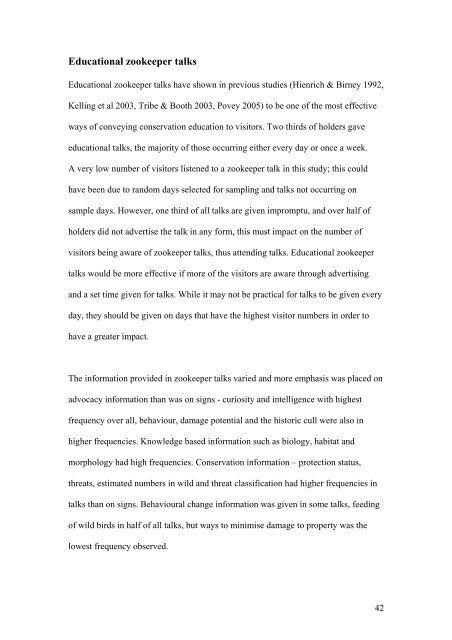Education of Zoo Visitors and Advocacy of Kea - Kea Conservation ...
Education of Zoo Visitors and Advocacy of Kea - Kea Conservation ...
Education of Zoo Visitors and Advocacy of Kea - Kea Conservation ...
You also want an ePaper? Increase the reach of your titles
YUMPU automatically turns print PDFs into web optimized ePapers that Google loves.
<strong>Education</strong>al zookeeper talks<br />
<strong>Education</strong>al zookeeper talks have shown in previous studies (Hienrich & Birney 1992,<br />
Kelling et al 2003, Tribe & Booth 2003, Povey 2005) to be one <strong>of</strong> the most effective<br />
ways <strong>of</strong> conveying conservation education to visitors. Two thirds <strong>of</strong> holders gave<br />
educational talks, the majority <strong>of</strong> those occurring either every day or once a week.<br />
A very low number <strong>of</strong> visitors listened to a zookeeper talk in this study; this could<br />
have been due to r<strong>and</strong>om days selected for sampling <strong>and</strong> talks not occurring on<br />
sample days. However, one third <strong>of</strong> all talks are given impromptu, <strong>and</strong> over half <strong>of</strong><br />
holders did not advertise the talk in any form, this must impact on the number <strong>of</strong><br />
visitors being aware <strong>of</strong> zookeeper talks, thus attending talks. <strong>Education</strong>al zookeeper<br />
talks would be more effective if more <strong>of</strong> the visitors are aware through advertising<br />
<strong>and</strong> a set time given for talks. While it may not be practical for talks to be given every<br />
day, they should be given on days that have the highest visitor numbers in order to<br />
have a greater impact.<br />
The information provided in zookeeper talks varied <strong>and</strong> more emphasis was placed on<br />
advocacy information than was on signs - curiosity <strong>and</strong> intelligence with highest<br />
frequency over all, behaviour, damage potential <strong>and</strong> the historic cull were also in<br />
higher frequencies. Knowledge based information such as biology, habitat <strong>and</strong><br />
morphology had high frequencies. <strong>Conservation</strong> information – protection status,<br />
threats, estimated numbers in wild <strong>and</strong> threat classification had higher frequencies in<br />
talks than on signs. Behavioural change information was given in some talks, feeding<br />
<strong>of</strong> wild birds in half <strong>of</strong> all talks, but ways to minimise damage to property was the<br />
lowest frequency observed.<br />
42












